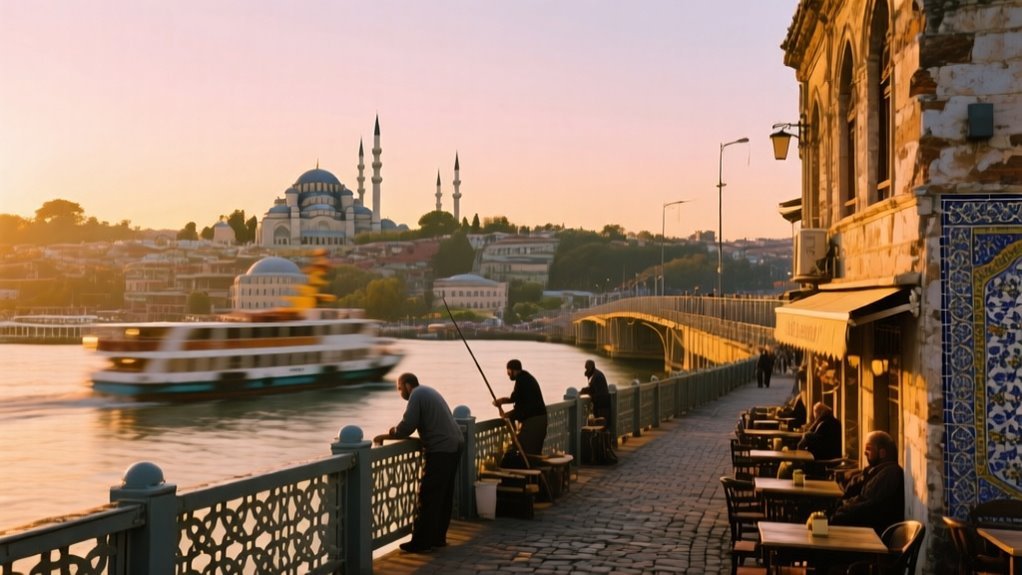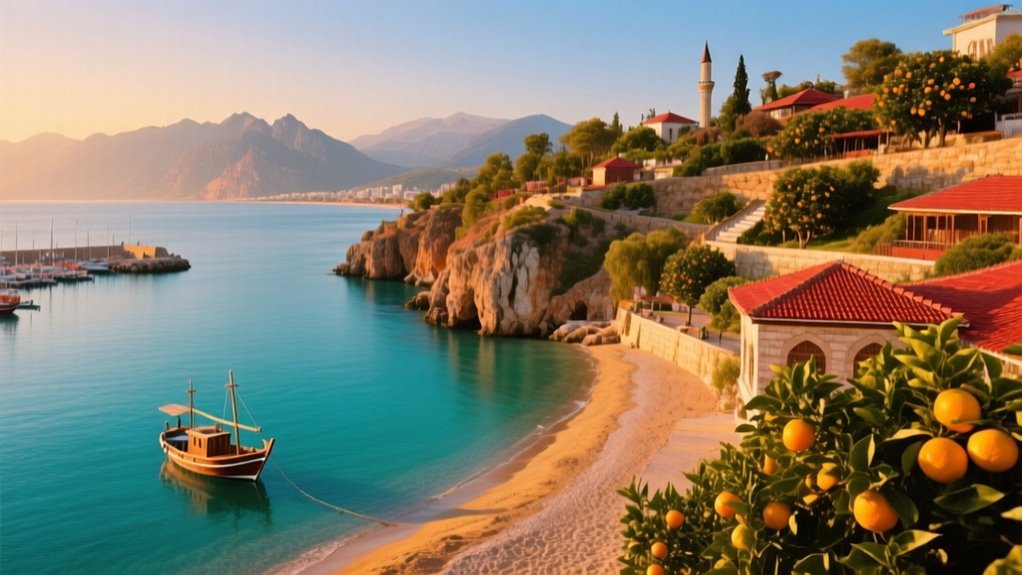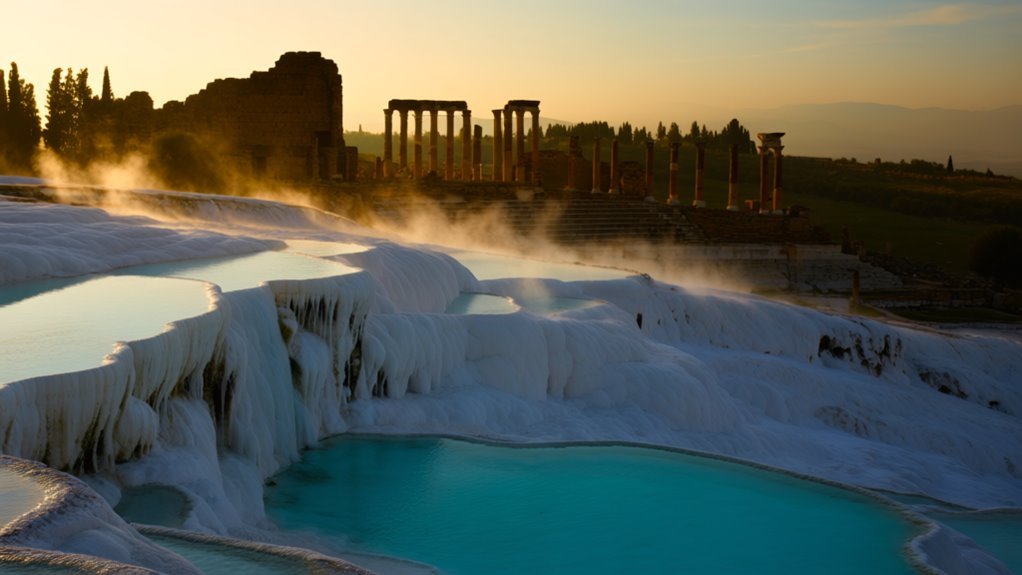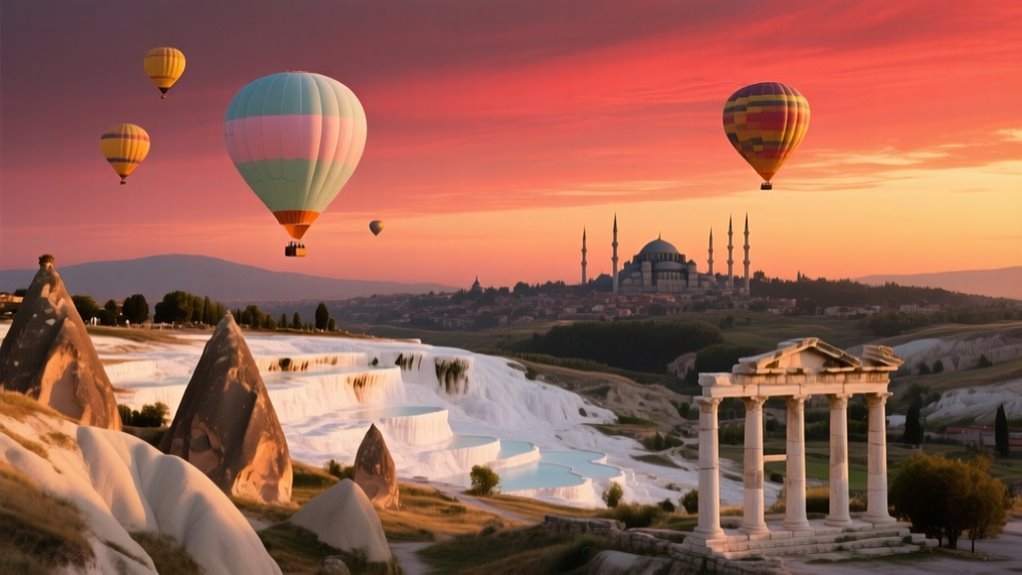You’ll love exploring Istanbul’s historic marvels like Hagia Sophia and the Blue Mosque, then venturing to Cappadocia’s surreal fairy chimneys and ancient cave homes.
Bask on Antalya’s stunning beaches, uncover Ephesus’s archaeological wonders, or relax in Pamukkale’s thermal terraces. For vibrant nightlife and sailing, Bodrum awaits.
Don’t miss Bosphorus cruises linking Asia and Europe or wander bustling traditional bazaars. Turkish cuisine ties it all together, promising unforgettable flavors.
There’s so much more waiting just ahead.
Key Takeaways
- Istanbul mesmerizes with iconic landmarks like Hagia Sophia, Topkapı Palace, and vibrant bazaars blending history and culture across continents.
- Cappadocia captivates with surreal fairy chimneys, cave dwellings, and scenic hot air balloon rides over volcanic landscapes.
- Ancient Ephesus offers well-preserved Greco-Roman ruins including the Library of Celsus and Temple of Artemis, showcasing deep archaeological heritage.
- Pamukkale’s dazzling white travertine terraces and nearby Hierapolis ruins combine natural beauty with historic thermal spa experiences.
- Bodrum enchants with lively nightlife, luxury sailing, pristine beaches, and charming marinas ideal for Mediterranean water activities.
Istanbul: A Blend of History and Culture

When you step into Istanbul, you’re not just visiting a city—you’re entering a living museum where history and culture intertwine effortlessly. You’ll explore UNESCO’s Historic Areas, including the Archaeological Park and Süleymaniye quarter, each preserving layers of Byzantine and Ottoman heritage.
Imagine wandering through iconic sites like Hagia Sophia, with its massive dome and intricate mosaics, or admiring the Blue Mosque’s six minarets and stunning İznik tiles. Topkapı Palace reveals the opulence of Ottoman sultans, while the Basilica Cistern showcases Byzantine engineering beneath your feet. Visitors can also enjoy a local Ottoman-style lunch showcasing traditional flavors and culinary history.
Don’t miss the Chora Church’s exquisite frescoes or the bustling atmosphere around Sultanahmet Square, once the Hippodrome’s center. Istanbul’s strategic location on the Bosporus links continents and centuries, offering you an immersion into a rich cultural tapestry. The area is recognized globally as the Historic Areas of Istanbul, a UNESCO World Heritage Site that highlights its vast historical significance.
Cappadocia’s Unique Geological Wonders
Although shaped over millions of years, Cappadocia’s otherworldly landscape feels like it belongs to an alien world rather than Earth. Volcanic eruptions blanketed the region in soft tuff, which erosion has since sculpted into mesmerizing fairy chimneys—tall rock spires capped with harder basalt stone.
As you explore, you’ll notice valleys like Love and Devrent, where rock formations evoke strange shapes and colors that shift beautifully at sunset.
This remarkable terrain inspired ancient inhabitants to carve homes, churches, and underground cities into the soft rock, creating one of the world’s largest cave-dwelling complexes.
When you wander through Göreme National Park, recognized by UNESCO, you’re stepping into a geological and cultural marvel shaped by natural forces and human hands alike.
To fully experience the region, visitors can stay in charming cave hotels that blend modern comfort with historic ambiance.
Exploring Antalya’s Coastal Charm

Antalya boasts one of the most stunning coastlines in the Mediterranean, stretching over 640 kilometers where lush forests meet the sparkling sea under the watchful gaze of the Taurus Mountains.
You’ll find pristine beaches like Konyaaltı and Lara offering powdery white sand and turquoise waters, perfect for swimming or sunbathing.
The coastal vibe mixes luxury with nature—upscale resorts, yacht-filled marinas, and Blue Flag beaches create a premium yet relaxed atmosphere.
Don’t miss Kaleiçi, Antalya’s historic old town with charming Ottoman houses, winding streets, and a marina ideal for sunset dining. The Yivli Minare, an iconic Seljuk-era fluted minaret decorated with blue tiles, stands as a striking architectural landmark in this district.
Beyond beaches, you can explore nearby waterfalls, hiking trails along the Lycian Way, or unwind in spa retreats, enjoying Antalya’s coastal charm throughout the year.
Discovering Ancient Ephesus
As you step into Ancient Ephesus, you’re entering a city that thrived for millennia where the turquoise Aegean once kissed its bustling harbor.
Founded by Ionic Greeks and relocated by Lysimachus, Ephesus was a key trade hub, protected by massive walls between Mt. Koressos and Mt. Pion. The city’s landscape exemplifies an outstanding settlement environment shaped by environmental factors that influenced its development over time.
You’ll witness ruins of the Library of Celsus, terrace houses, and even the sparse remains of the majestic Temple of Artemis, one of the Seven Wonders of the Ancient World. A guided tour allows visitors to explore the great theatre and other significant archaeological sites.
Christianity also shaped the city with landmarks like the Basilica of St. John.
This UNESCO World Heritage Site offers a vivid glimpse into a diverse cultural and religious past.
Pamukkale and Hierapolis: Thermal and Historical Treasures

You’ll be captivated by Pamukkale’s dazzling white travertine terraces, where warm thermal waters create a stunning natural wonder. The landscape is shaped by calcium carbonate deposits forming breathtaking terraces and pools that vary from one to six meters in height.
Just above, the ancient ruins of Hierapolis invite you to explore Roman theaters, temples, and sacred sites rich with history. This blend of natural beauty and cultural heritage is reminiscent of the diverse historical sites found throughout Turkey.
After wandering these remarkable spots, you can soak in healing hot springs that have drawn visitors for centuries.
Travertine Terraces Beauty
What creates the dazzling white terraces of Pamukkale, cascading like frozen waterfalls across the Turkish landscape? It’s the calcium carbonate-rich thermal waters flowing over the limestone surface, depositing minerals as they cool and evaporate. This process forms pristine travertine layers, giving the terraces their unique, bright white appearance.
When you explore Pamukkale, you witness nature’s artistry shaped by:
- Hot springs ranging from 35 °C to 100 °C, supplying mineral-rich water that solidifies into travertine
- Dynamic terrace growth through mineral precipitation concentrating at the edges where water flows faster
- Regional tectonic forces driving geothermal waters upward through limestone bedrock, nurturing terrace formation over millennia
The terraces are part of a complex hydrogeological system where hot spring water dissolves limestone and deposits calcium carbonate as it cools, resulting in ongoing travertine accumulation at the surface (hydrogeological system).
As you walk these terraces, you’re witnessing an ongoing geological masterpiece sculpted by hydrothermal chemistry and time.
Ancient Hierapolis Ruins
Beyond the stunning white terraces of Pamukkale lies the ancient city of Hierapolis, a remarkable archaeological site where history and myth intertwine.
As you explore, you’ll encounter ruins like the grand Roman theater and the Apollo Temple, closely tied to the city’s divine origins.
Descend near the Plutonium cave, intriguingly linked to the underworld through toxic gases once considered sacred.
This site was notably rebuilt after a major earthquake in 60 CE, showcasing resilience through centuries. major earthquake
Wander through the vast necropolis filled with tombs and inscriptions revealing centuries of cultural shifts.
These include Phrygian cults and Christian sanctuaries, such as the tomb of Apostle Philip.
Hierapolis offers a vivid glimpse into a city shaped by religious rites, diverse populations, and layers of Greek, Roman, and Byzantine influence.
This makes it a compelling destination for history lovers eager to connect with Turkey’s ancient past.
Thermal Spa Experiences
How often do you get to soak in mineral-rich waters that have healed and delighted visitors for over two thousand years? At Pamukkale and Hierapolis, you’ll immerse yourself in warm, calcium-rich thermal springs cascading down brilliant white travertine terraces. These terraces, formed by calcium carbonate deposits, give the landscape its iconic “cotton castle” appearance. This unique blend of natural wonder and history offers a therapeutic experience unlike any other.
Here’s what you can look forward to:
- Bathing in the Antique Pool, surrounded by submerged ancient ruins.
- Exploring terraces formed by mineral deposits reaching six kilometers.
- Enjoying therapeutic waters famed for treating skin and cardiovascular conditions.
As you wander barefoot over the surreal landscapes, you’ll feel the lasting legacy of ancient spa culture merging with modern wellness—a truly memorable Turkish adventure.
Bodrum’s Vibrant Coastal Lifestyle
You’ll find Bodrum buzzing with energetic nightlife, where beachfront bars and clubs keep the party alive well into the early hours.
Daytime offers endless opportunities for sailing and water sports, with luxury yachts and vibrant marinas dotting the coastline. This diversity is a key element in Türkiye’s efforts to expand tourism beyond the classic “sea, sun, and sand” model, incorporating diverse tourism offerings. Many travelers combine their coastal visits with exploring historical sites like those found on the Istanbul Antalya Pamukkale Ephesus Cappadocia tour.
Whether you crave lively entertainment or sun-soaked adventures on the water, Bodrum perfectly blends both for an unforgettable coastal experience.
Nightlife and Entertainment
When night falls along Bodrum’s Aegean coastline, the city transforms into a dazzling hub of vibrant nightlife and entertainment. Known as the “Ibiza of Turkey,” Bodrum offers everything from elegant cocktail bars to pulsating open-air clubs with stunning sea views.
Whether you’re craving live jazz, eclectic underground beats, or high-energy dance parties, the options are endless. Safety is well-managed in popular areas, letting you enjoy worry-free nights.
Explore unique venues that blend sophistication with local charm, ensuring memorable evenings along this coastal gem.
Dance the night away at Halikarnas’ open-air sea-view club.
Savor craft cocktails at L’Opera Bar with live jazz ambiance.
Experience floating parties aboard the Catamaran Club with panoramic bay views.
Sailing and Water Activities
Where do yacht lovers flock to experience the true essence of coastal living? Bodrum’s vibrant bays, buzzing with over 50,000 yachts in 2024, have become a sanctuary for sailing enthusiasts. You can explore routes like Bodrum to Kara Ada or Aspat Bay, soaking up snorkel spots, ancient ruins, and tranquil bays.
The sailing season runs April through October, with May, June, and September offering ideal warm weather and moderate breezes. Bodrum’s traditional gulets invite you to experience Turkey’s rich maritime heritage, while modern marinas provide premium facilities. The influx of yacht traffic has significantly boosted local tourism revenue, strengthening the regional economy.
Be ready for strong Meltemi winds in summer afternoons and watch the weather closely for safe sailing. Beyond adventure, increased yacht traffic powers local businesses, making your coastal journey both thrilling and economically impactful.
Scenic Bosphorus Cruises Connecting Continents
Although Istanbul bustles as a vibrant metropolis, the Bosphorus Strait offers you a tranquil escape through time and geography. Cruising this narrow waterway, which divides Europe and Asia, immerses you in layers of history and stunning landscapes. You’ll glide past historic fortresses, lavish palaces, and charming waterfront mansions, all set against the backdrop of shimmering waters and green shores. The strait itself connects the Black Sea with Sea of Marmara, making every journey a passage between two important bodies of water.
On your journey, be sure to take in:
- The majestic Dolmabahçe Palace and Ortaköy Mosque framing the water’s edge
- Iconic landmarks like Maiden’s Tower and Rumeli Fortress signaling centuries of heritage
- The architectural marvels of Bosphorus and Fatih Sultan Mehmet bridges connecting continents
Choose from affordable public ferries or intimate private cruises to experience the Bosphorus’s timeless beauty and cultural richness firsthand. You can also enjoy special experiences like the Bosphorus dinner cruise with show to enhance your visit.
Traditional Markets and Bazaars Across Turkey
Why do traditional markets remain so essential in Turkey despite the rise of modern retail? When you explore bazaars like Istanbul’s Grand Bazaar or Ankara’s Kızılay Market, you’ll find vibrant hubs where history meets daily life.
These markets aren’t just shopping spots; they preserve centuries-old customs and fuel local economies by offering fresh produce, handmade crafts, and specialty goods. You’ll discover bakkals stocking essentials and niche shops focusing on textiles or spices, each with its unique charm. In fact, traditional retail channels account for 57% of total grocery spend, except Istanbul where modern trade dominates.
Though modern chains grow, traditional markets still capture over half of grocery spending outside Istanbul.
Stepping inside, you feel the pulse of Turkish culture—an experience no supermarket can match.
Embracing both authenticity and community, these bazaars remain indispensable to Turkey’s spirit and economy.
Experiencing Turkish Culinary Diversity
After exploring Turkey’s bustling traditional markets, your senses are primed for the next adventure: experiencing the country’s rich culinary diversity. Turkish cuisine is a vibrant tapestry woven from Central Asian, Ottoman, Mediterranean, and Middle Eastern influences.
Immerse yourself in Turkey’s rich culinary tapestry, where diverse cultural influences create unforgettable flavors.
Each region offers unique flavors shaped by history and geography. The distinct culinary traditions of Eastern Anatolia, Southeastern Anatolia, Central Anatolia, Black Sea, Thrace, Marmara, Aegean, and Mediterranean regions illustrate the depth of this regional diversity. Many pilgrims traveling for religious purposes also enjoy these regional culinary experiences during their journey, enriching their cultural insights.
To truly savor this diversity, focus on mastering these delights:
- Coastal Aegean flavors in Kuşadası, featuring fresh seafood like çipura and midye dolma.
- Central Anatolian specialties such as mantı, keşkek, and gözleme, highlighting hearty grains and meat.
- Antalya’s distinctive tahinli piyaz and Hülüklü çorba, reflecting Mediterranean and local traditions.
Dive into Turkish culinary culture, where fragrant herbs, olive oil, and diverse spices combine in dishes that tell stories of trade routes and empires. The practice of partaking in regional food rituals parallels the multi-day pilgrimage experiences found in other cultural traditions, emphasizing community and spiritual connection.
Frequently Asked Questions
What Are the Best Times of Year to Visit Turkey?
Imagine Turkey as a vibrant tapestry that changes hues with the seasons.
You’ll find spring and fall perfect—mild temperatures and colorful landscapes invite you to explore ancient ruins or meander scenic trails.
If you’re chasing sun and sea, summer shines bright along the coasts, though crowds swell.
For a quieter, snow-kissed adventure, winter offers serene beauty and skiing.
Choose your season based on the experiences you crave, and Turkey will unfold its magic just for you.
Is Turkey Safe for Solo Travelers and Families?
Yes, Turkey’s generally safe for both solo travelers and families, especially in major cities like Istanbul or coastal resorts.
You’ll want to avoid eastern border areas due to higher security risks.
Stay alert for petty scams but don’t worry too much about violent crime. It’s quite low.
If you’re a solo female traveler, modest dress and daytime exploration help.
Families should watch road safety and prefer bottled water.
How Do I Obtain a Visa for Traveling to Turkey?
To obtain a visa for Turkey, you’ll usually apply online for an e-Visa before traveling, especially if you’re entering by air.
Make sure your passport is valid for at least six months beyond your stay, with one or two blank pages.
Fill out the application carefully in capital letters and submit it.
After approval, use the e-Visa within six months.
For longer stays, visit a Turkish embassy to get the right visa.
What Currency Is Used and Are Credit Cards Widely Accepted?
When it comes to money in Turkey, you’ll find the Turkish lira (₺) is the currency used.
Credit cards are widely accepted, especially in cities and tourist hotspots, so you won’t be left holding the bag.
Still, in rural areas and markets, cash often rules.
It’s smart to carry both cash and cards to stay flexible—grab lira at banks, ATMs, or exchange offices to get the best bang for your buck.
Are There Any Cultural Customs Tourists Should Be Aware Of?
You should know that tea is central to Turkish hospitality, so politely accept or use a hand-on-chest gesture to refuse.
Dress modestly, especially outside tourist areas and religious sites—cover shoulders and legs.
When dining, use your right hand and tuck your feet away if sitting on cushions.
Be punctual, respectful to elders, and avoid public drunkenness.
Learning some Turkish phrases will impress locals and enhance your experience.
Conclusion
As you journey through Turkey, you’ll immerse yourself in a tapestry woven with history, vibrant culture, and breathtaking landscapes.
From Istanbul’s bustling bazaars to Cappadocia’s fairy-tale chimneys, each destination whispers stories waiting for you to discover.
Let the turquoise waves of Antalya and Bodrum’s lively shores refresh your soul, while ancient ruins and thermal springs awaken your curiosity.
Turkey isn’t just a place; it’s an invitation to ignite your senses and write your own travel tale.


0 Comment